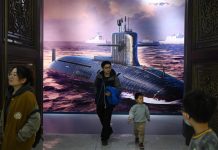Over the course of its history, the United States Air Force has seen the development of an array of top-notch aircraft. A few of them, however, could never really take flight despite being destined for great things. The XB-70 Valkyrie is one such aircraft.
Developed by North American Aviation, the XB-70 Valkyrie strategic bomber was meant to serve as the backbone of the USAF’s Strategic Air Command (SAC).
During the early years of the Cold War, before there was a reliance on intercontinental ballistic missiles, strategic bombers were the primary means of delivering nuclear missiles.
There was a need for a large strategic bomber to deliver the nuclear weapons to locations inside the erstwhile Soviet Union. The new bomber had to be very fast, with the ability to carry large nuclear payloads. It had to carry enough fuel to reach targets within the Soviet Union and then come back.
According to defense writer Caleb Larson, the aircraft was originally designed to be a combination of two different American bombers in order to possess the strengths of both.
“Initially, designers sought to combine the massive heavy lift capabilities and range of the venerable B-52 bomber with the speed of the new Mach 2 capable B-58 Hustler bomber. High speed was seen as absolutely necessary to get the bomber and its crew to safety as far away from the nuclear explosion as possible,” said Larson.
The XB-70 Valkyrie was built as a high-altitude, super-fast strategic bomber, which possessed the ability to drift into the airspace of the Soviet Union.
The bomber could fly at an altitude of 70,000 feet as a defense against enemy surface-to-air missiles.
The jet could surpass the speed of the B-58 and attain speeds of Mach 3, which was made possible due to the presence of six turbojet engines which produced 28,000 pounds of thrust each, with an afterburner.
Moreover, while the bomber was made large on purpose, its weight was minimized by utilizing light-weight honeycomb paneling and titanium.
According to NASA Armstrong Fact Sheet, which contains information about aircraft, flight tests and research projects, among others, “To achieve Mach 3 performance, the B-70 was designed to ‘ride’ its own shock wave, much as a surfer rides an ocean wave.
The resulting shape used a delta wing on a slab-sided fuselage that contained the six jet engines that powered the aircraft. The outer wing panels were hinged. During take-off, landing, and subsonic flight, they remained in the horizontal position.”
“This feature increased the amount of lift produced, improving the lift-to-drag ratio. Once the aircraft was supersonic, the wing panels would be hinged downward. Changing the position of the wing panels reduced the drag caused by the wingtips interacted with the inlet shock wave.”
The aircraft also led to the development of an exotic new boron-based fuel known as ‘Zip Fuel’, which was considered more energy-dense than gasoline or jet fuel.
However, while the fuel was meant to give range and speed advantages to the XB-70, its exhaust was considered toxic.
“While toxicity wouldn’t necessarily be a problem while in flight, ground crews servicing engines that ran on zip fuel would need extensive personal protective equipment,” said Larson.
“Zip fuel exhaust particulates are also extremely corrosive, compounding the problem… Designers opted for the less energy-dense but more stable jet fuel.”
This was one of the contributing factors as to why the XB-70 was just restricted to a mere prototype. Another problem, in particular, was that while the bomber was built to be superfast, the Soviet defense missiles were even faster than the XB-70.
The Soviet-designed S-75 Dvina high-altitude air defense system, which was built around a surface-to-air missile with command guidance, could attain speeds of up to Mach 3.5 and even fly higher than the XB-70.
There were suggestions that the XB-70 could indeed be used to fly at lower altitudes under the speed of Mach 1 in order to be effective, however, that defeated the purpose for which it was built.
As a result, the XB-70 program despite holding many promises was brought to a permanent halt in 1962. However, despite its failure, the aircraft contributed to the development of the B-1B Lancer bomber, the SR-71 Blackbird spy plane, and other projects.




